-
Posts
6,366 -
Joined
-
Last visited
Content Type
Profiles
Forums
Gallery
Events
Posts posted by wefalck
-
-
Thanks for the kind comments

I am shortsighted (+4 something), so when I take off my glasses, I get a sort of 'loupe' effect immediately. For many tasks, particularly those involving machines, I am wearing just a pair of protective glasses. I also have set of protective glasses that are magnifying (factor 3) and for really small work, where I need to see in 3D, I indeed use an 'optivisor', but don't find it very comfortable.
Some years ago I purchased a set of frames with little telescopes attached to it, of the kind dentists or surgeons use, but found that the field of vision is too small and the working distance to wide in order to work comfortably when sitting at the bench. I gather they are designed for towering over the patient while standing up ... so I don't really use them.
-
It has been almost a year since the last post. I have been too busy business-wise and been side-tracked by various tool-making projects, which seem to be easier to do with the frequent interruptions by business-travels. There has been some small progress, however. Though this was not easy, as I have been struggling with the possibilities of the available materials and with my own skills. The 1/160 is pretty small, if you have set yourself the target to put as much detail into as one would do in say 1/96 or even 1/48 scale ... One of my struggles has been to produce acceptable ladders, on which I will report in the next post.
*********************************************************
The officers’ mess skylight produced previously did not turn out quite to my satisfaction. It was not as crisp as I had wished. It was build up from layers of bakelite sheet around a milled core of acrylic glass. The mouldings present on the original were simulated by 0.4 mm copper wire milled to half-rounds. This all entailed messing around with cyano-acrylate cement, which is not my favourite and at which I am not very skilled.
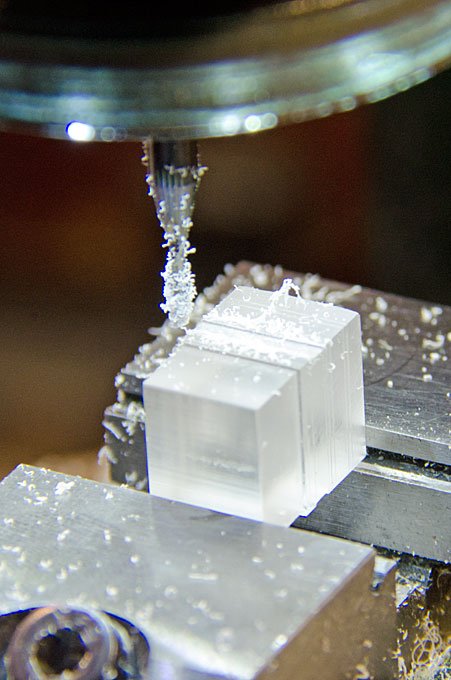
Officers’ mess skylight milled from a small block of acrylic glass
It then occurred to me that much of all this could be milled from a solid piece of acrylic glass. One has to start from a block that envelopes the maximum width and depth, including the mouldings, and then has has to plan strategically which layers to mill off until the desired shape appears (reminds me of the joke, where an old lady asked a sculptor during an exhibition whether it was difficult to sculpt a lion – the artist replied: not really, madam, one takes a big block of marble and knock off everything that doesn’t look like a lion ...). The mouldings were left standing as square protrusions. They were rounded off using a draw-plate fasioned from a piece of razor-blade and held in a pin-vise. The half-round notch was cut using a thin cut-off wheel mounted on an arbor in the milling machine.
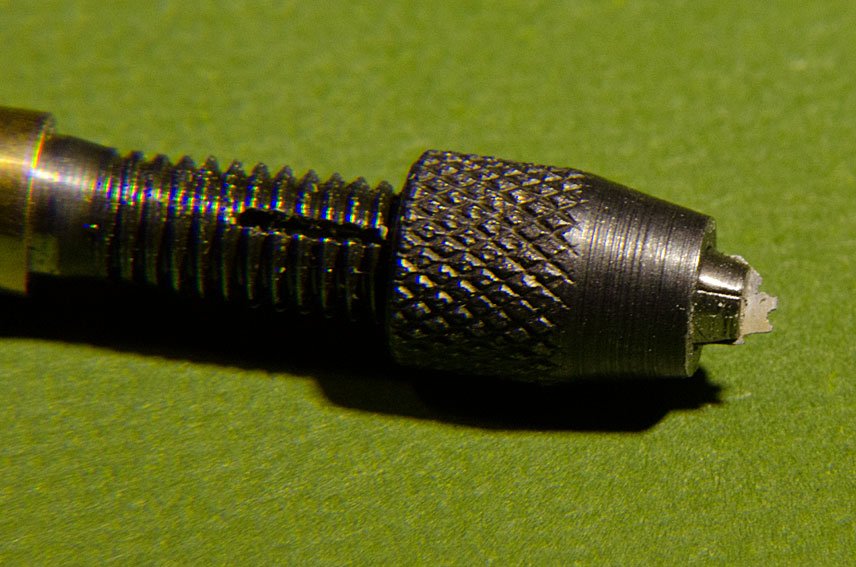
Micro-drawplate for half-round moldings
It is, of course, not possible to simulate panelling by this method. However, some parts can be left standing and the other completed with thin styrene-strips. For reasons of material stability, I am not such a big fan of polystyrene, it becomes brittle with age, but it has the advantage that it can be ‘welded’ onto acrylic glass or onto itself using dichlormethane. This results in invisible bonds and you cannot smear any glue around.
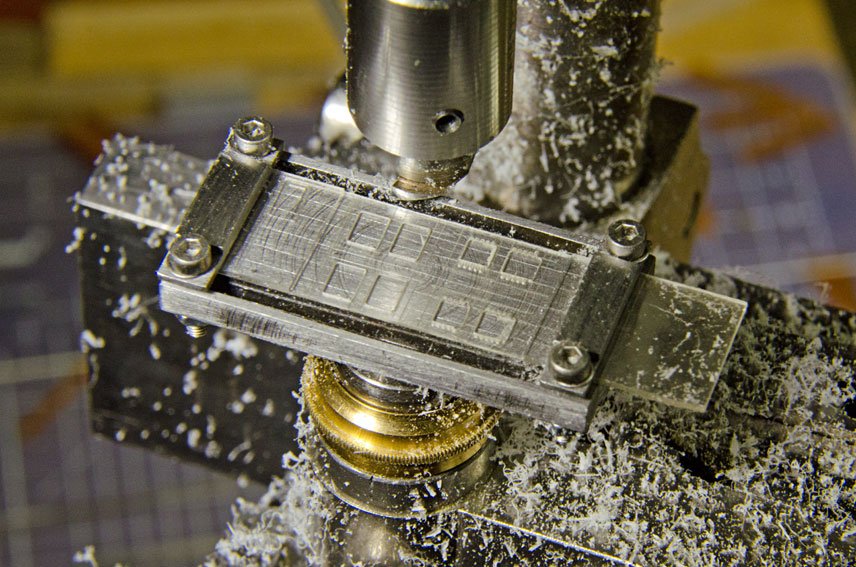
Trial of milling out skylight window-frame
The next challenge were the protective grilles that were laid into the wooden frames above the actual skylight glass-panes. The bar of brass or bronze had a diameter of less than a centimetre, which translates to something like 0.05 mm on the model. However, the thinnest brass-coloured wire I could find had a diametre of 0.1 mm, so is slightly oversize. Recently I came across molybdenum wires that are readily available down to diametres of 0.02 mm ! It seems that they are used in the repair of mobile phones, to separate the front-glass from the LCD-display. I obtained a selection of sizes, but have not worked with the wires yet. The wires are supposed to be tough, so I do not know how easy it is to cut them to length.
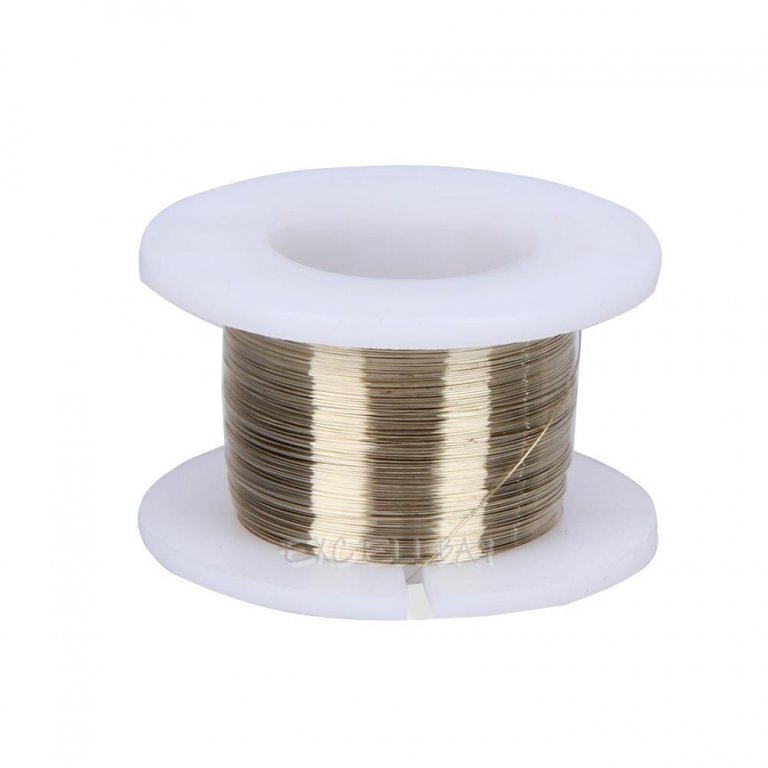
Spool of gold-coloured molybdenum wire
I tried various methods to construct the window-frames with exactly spaced out bar. In the first instance I tried to mill-out the frame from a thin piece of acrylic glass. Evenly spaced notches for the ‘bars’ were milled with a pointed engraving bit. However, I did not manage to get the edges and corners as crisp and clean as desired.
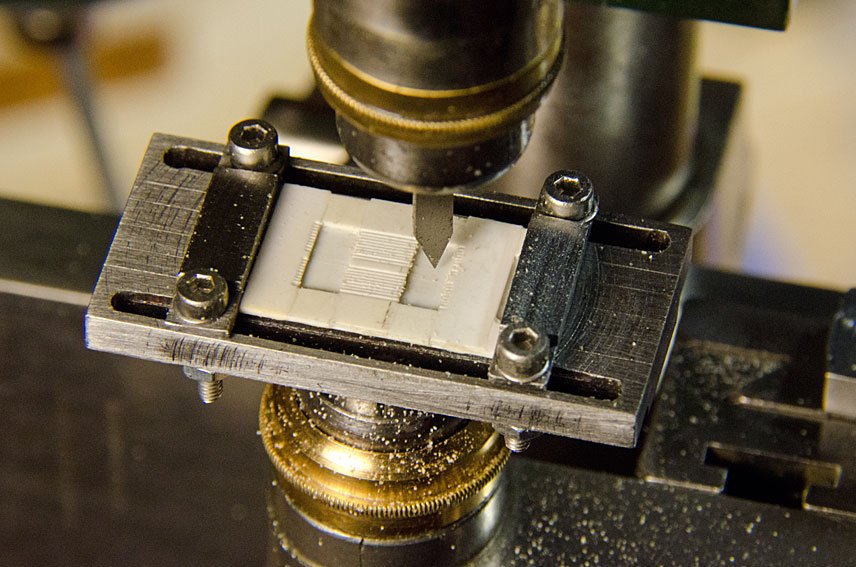
Milling notches for window bars
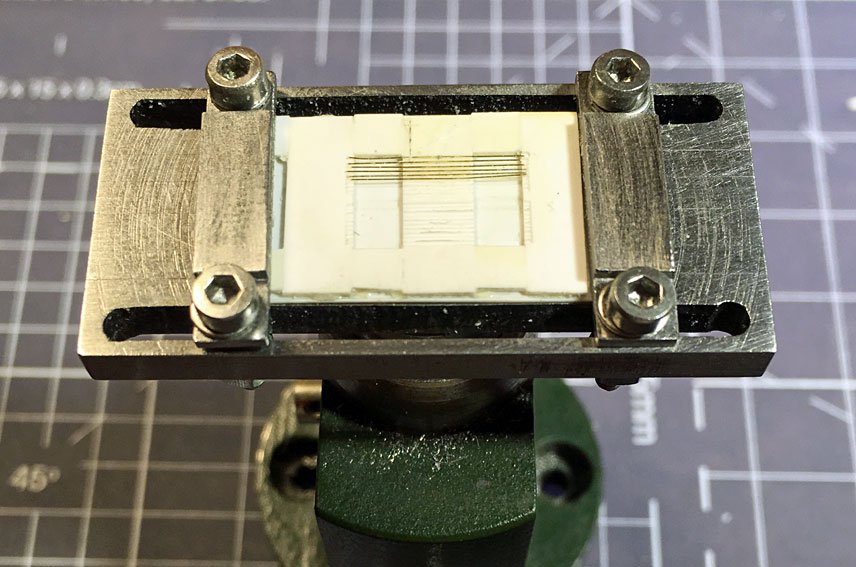
Placing wires as window bars
I then wanted to construct the frame near-prototype fashion. To this end I drilled holes for the 0.01 mm wires into the edges of 0.5 mm by 1.0 mm strips of styrene. It proved difficult, however, to align the four parts of the frame well enough.
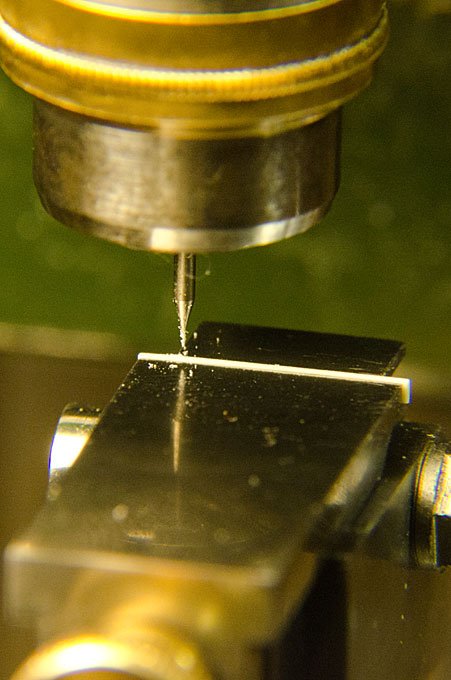
Drilling frame for protective bars
In the final version I welded 0.25 mm thick strips of styrene onto the milled acrylic glass body of the skylight. The block then was presented at the correct angle to an engraving cutter in the milling machine and the notches for the wires cut. In the next step the wires were glued into these notches, which was a major challenge – for the steadiness of my hand and my patience ...
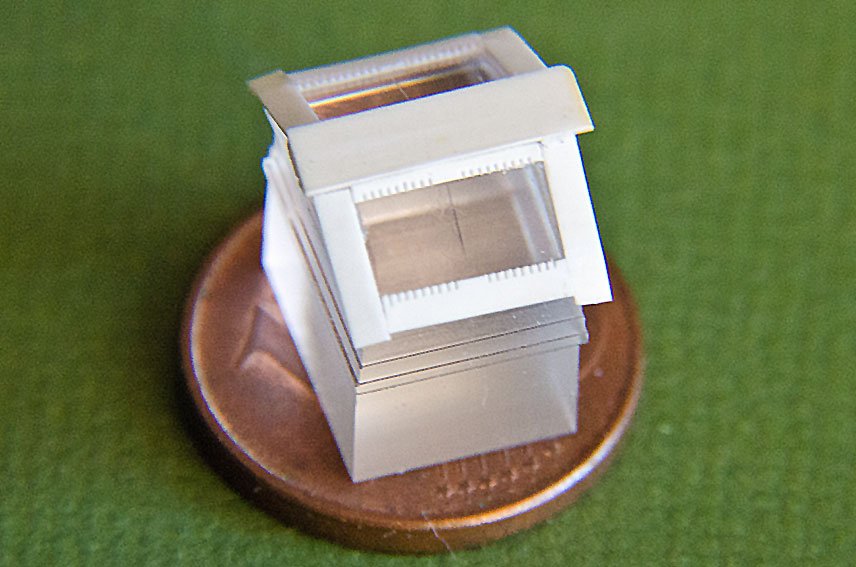
Built-up frames
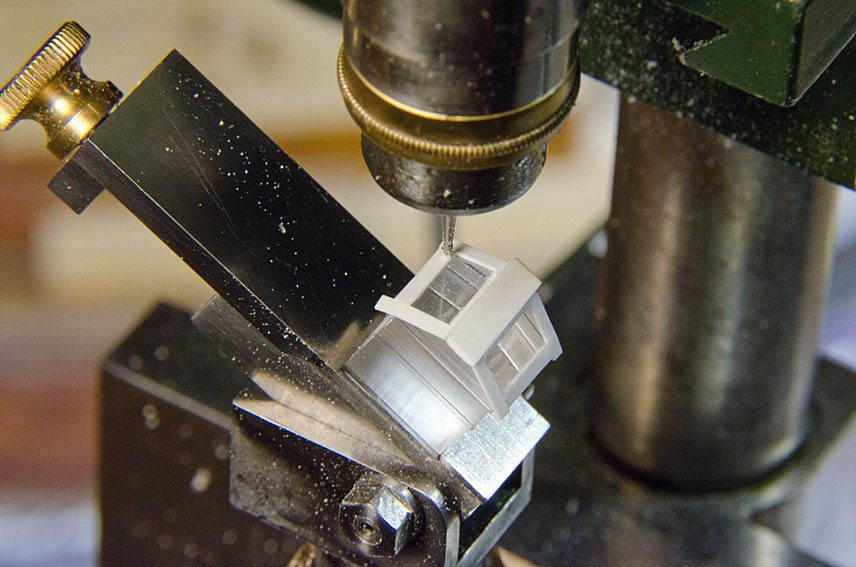
In situ milling of notches for wire bars
The frame was completed by another layer of 0.25 mm styrene strips. As the total thickness should have been only 0.4 mm, the excess was sanded off on the milling machine. Finally, the edges were trimmed to size and rounded with the draw-plate described above.
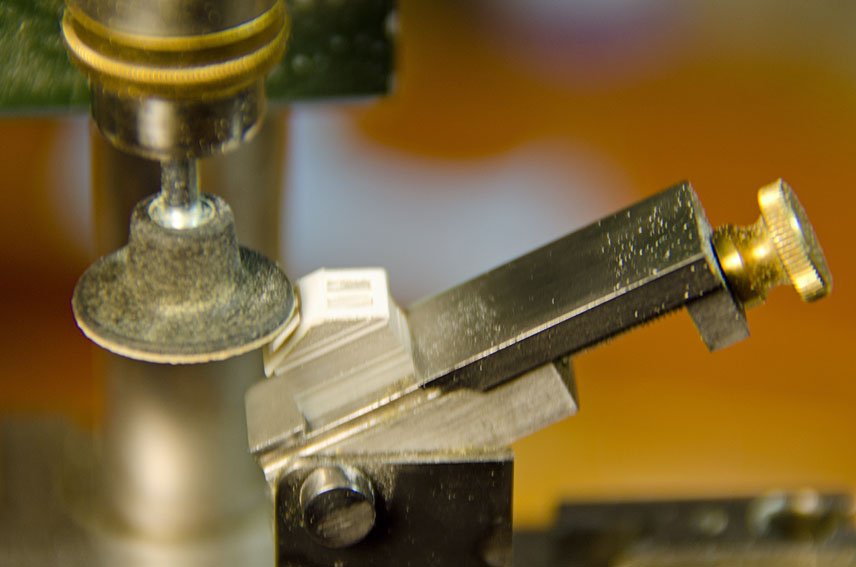
Sanding frames to scale thickness
The officers' mess skylight will receive an outside protective grille on the basis of an etched part.
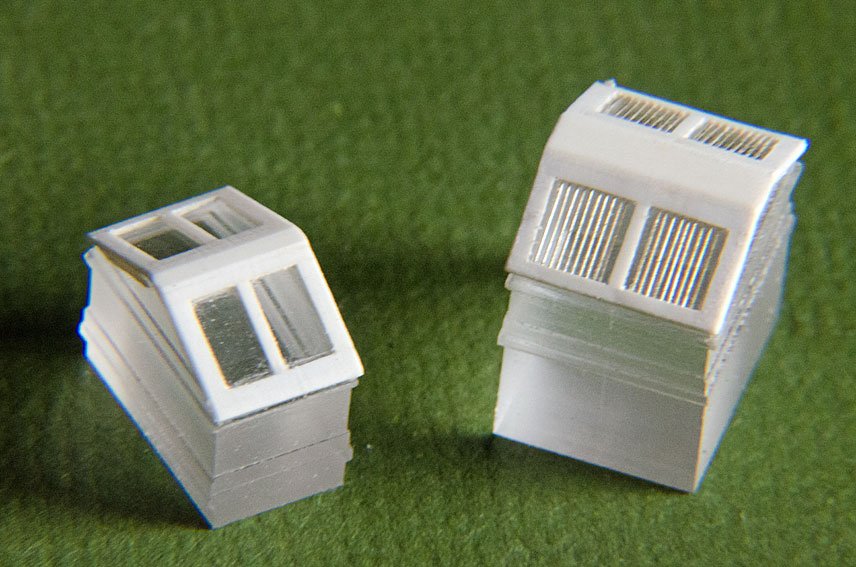
Completed skylights for the pantry (left) and the officers’ mess (right)
To be continued ....
-
Rather than bakelite (which is phenolic resin filled with wood flour and which is essentially isotropic) I received ‘Novotext’ rods. Novotext is a composite of phenolic resin and cotton fabric. This is bad and good news. The bad news is that its temperature resistance is lower than that of bakelite and, hence, the clamps cannot be used for soldering as originally envisaged. The good news is that Novotext is much less brittle and more elastic than bakelite because the cotton fabric takes up the strain, as does the steel in re-enforced concrete. The material mill and turns well, and you can cut threads in it. So the design is the same as that for the metal clamps. In the end I got some nice clamps out of it, nicer than the wooden ones I attempted.
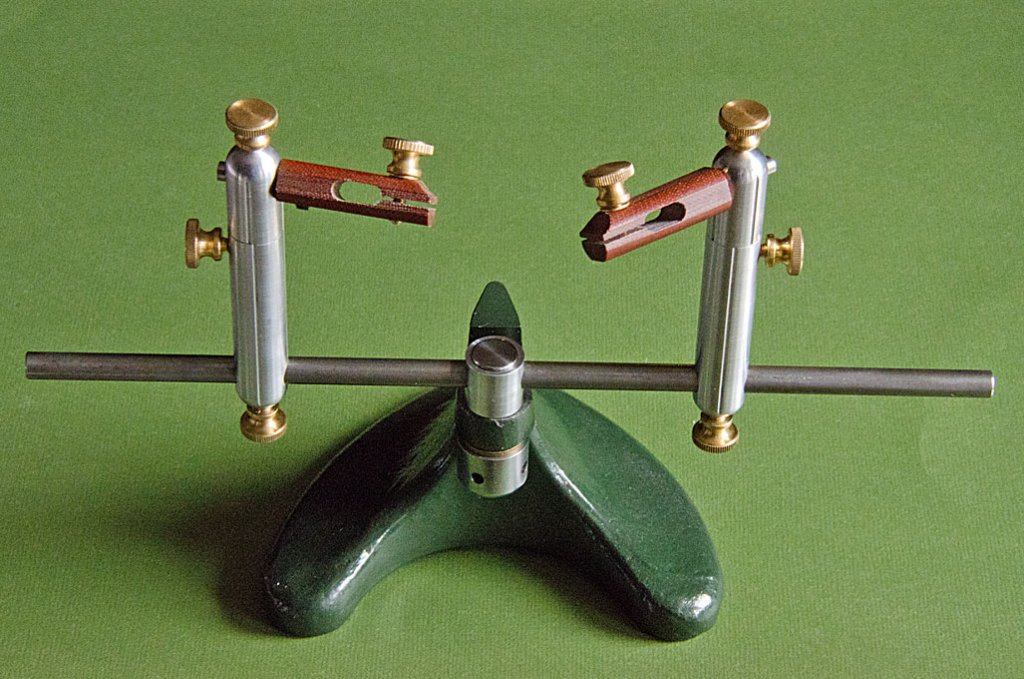
Third hand with made from ‘Novotext’.
Some people asked me about the construction details and below you find an ‘exploded diagram’ of the tool.
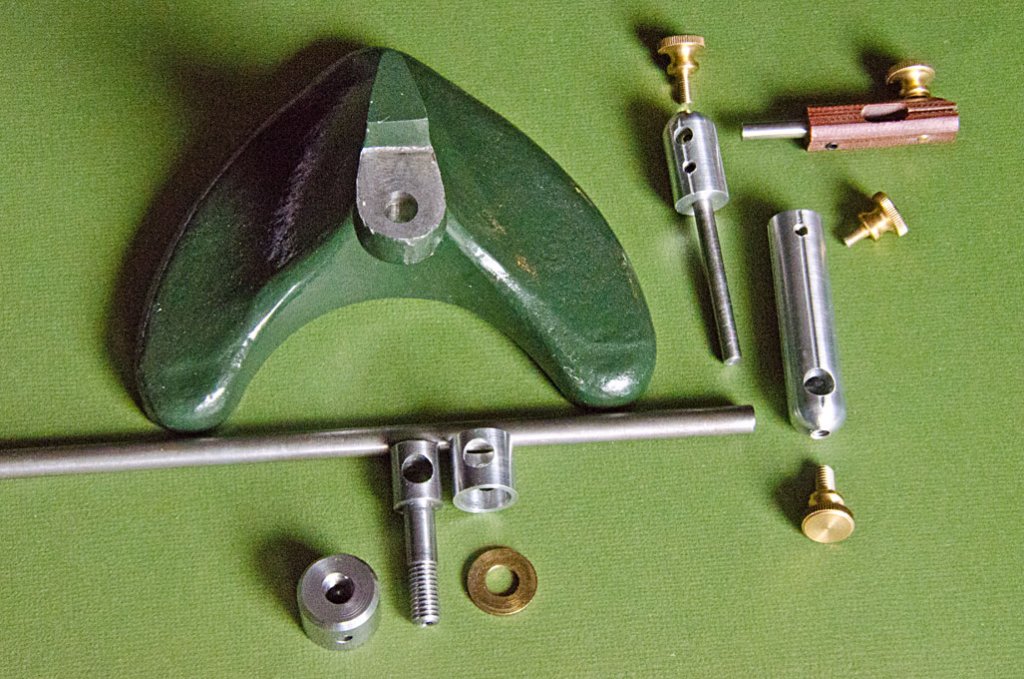
Third hand ‘exploded’
- Canute, michael mott, Mike Y and 4 others
-
 7
7
-
Not having used the tool/product in question, I am not in a position to comment on its utility. However, I would prefer to work 'in situ', that is having the shrouds set up properly before starting 'rattling out'. I would find it difficult and too nerve-wrecking to transfer the net, that is effectively constructed, onto the model without some distortions occurring.
In practice, I drew the layout of the shrouds and ratlines on a piece of card that is inserted behind the shrouds. It's then like working on a drawing and you will see any pulling-in of the shrouds and uneven spacing of the ralines immediately. Don't fix the knots until you are finished completely so that you can adjust things if still needed.
- BETAQDAVE, Canute, Ryland Craze and 3 others
-
 6
6
-
Personally, I would not put a collet-block into a lathe-chuck. If you are looking for something to hold smaller diameter stuff and can't exchange the 3-jaw-chuck on the lathe with a collet-chuck, or if you lathe spindle doesn't have a taper to take in collets, I would use a round collet-holder like this one seen in a random ebay-offer:
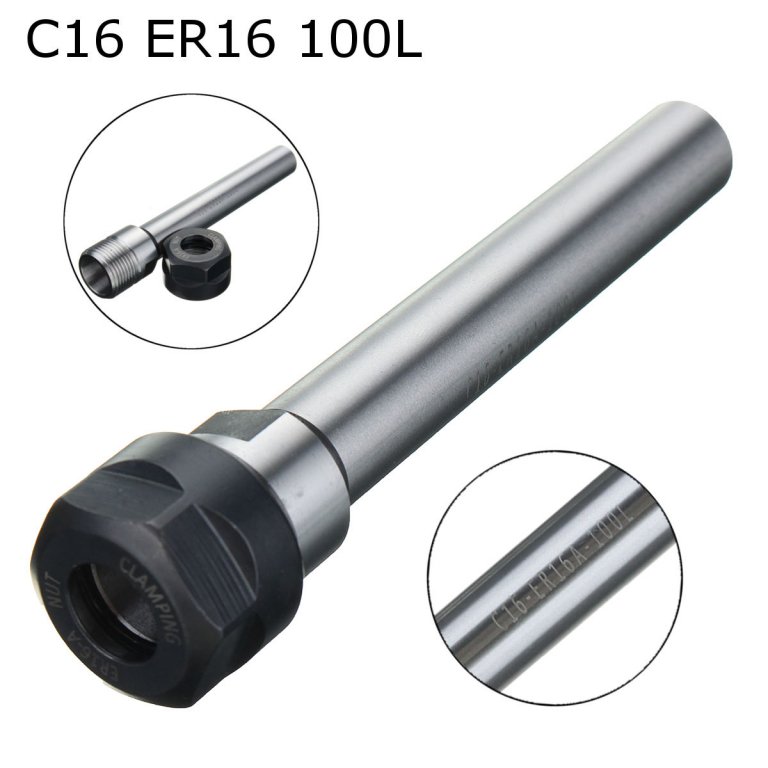
There are literally dozens of offers. They are too long to be taken into a 3-jaw-chuck, but you can shorten them using an abrasive disk or even on the lathe itself with a carbide cut-off tool. They start from ER8 collets upwards and cost from 6€ upwards.
Another option would be to fashion the blocks oneself from square or hexgonal stock. The threaded clamping nut is a bit special inside and is best bought in.
-
Alcohol has higher vapour pressure than water, hence it evaporates faster ...
What effect alcohol has on acrylic paints depends on the brand. Some brands actually use alcohol in their spray-ready formulations and these are recommended to be thinned with alcohol or an alcohol/water mixture. These paints are quite complex emulsions of acrylic polymers, pigments and solvents. If you change the composition, e.g. by thinning, the emulsions can break down and the acrylic polymers and pigments might curdle - in the worst case they may clog the airbrush or at least you might get an uneven coverage.
The 'drying' of acrylic paints is a combination of processes, in addition to the already mentioned evaporation and sucking up of solvent into a porous substrate, the acrylic polymers slowly beginn to develop physico-chemical cross-links between each other. This process can take several weeks. Thus, initially the paint surface is typically quite soft and rubbery and only hardens with time.
- Canute, Altduck, thibaultron and 1 other
-
 4
4
-
Levin, Hardinge and other manufacturers of watchmaking lathes have been selling such collet-blocks for a long time. They come together with a sort of V-block for simple grinding, sawing, or milling operations in the lathe:
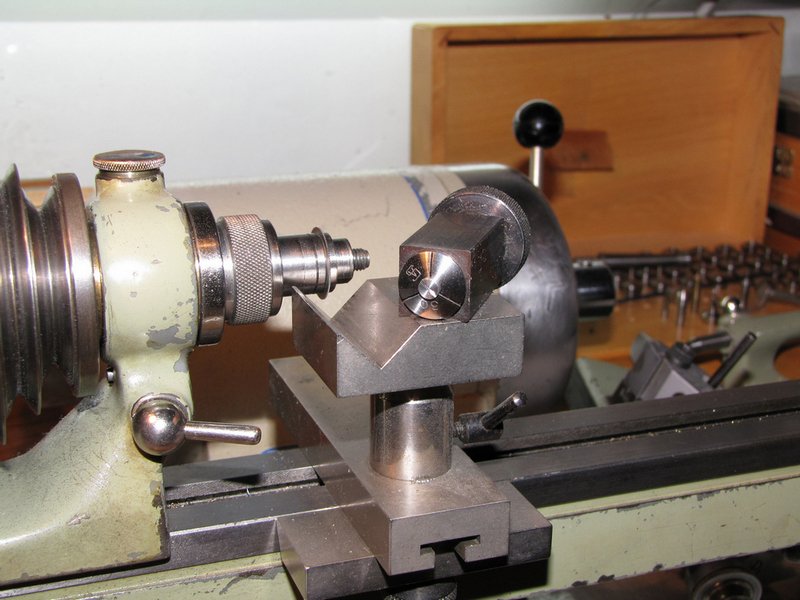
Picture borrowed from http://www.geocities.ws/dushang2000/Horology/Lathe Tools/Lathe Tools.html, as I was to lazy to take a picture of my own set.
These blocks can be used with collets as well as the various types of chucks. I also use them, of course, in the vice on my milling machines. In the picture you see at the end a knurled wheel. This is not the draw-bar wheel, but sits on a fine thread at the back of the holder and thus forms a finely adjustable depth-stop.
Some time ago I got some hexagonal bar-stock and plan to fashion a hexagonal collet holder from it, when I have time ...
Incidentally, many year ago I also fashioned an upright collet holder that clamps to the table of the mill:
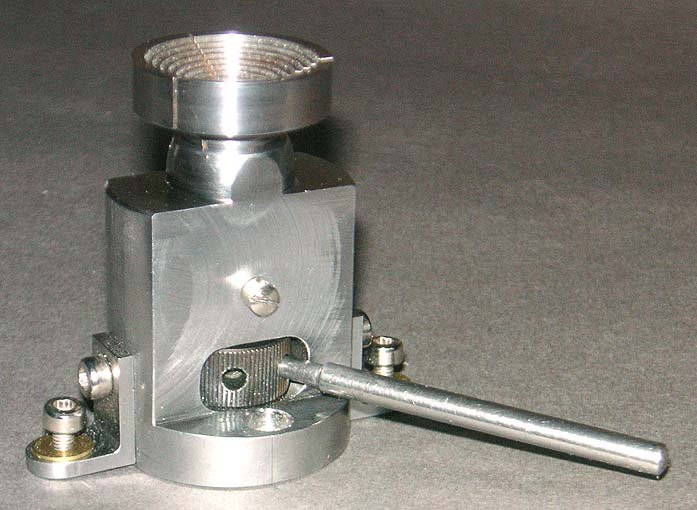
- BANYAN, mtaylor, Rik Thistle and 3 others
-
 6
6
-
-
Got the chuck and collets from ebay. It is same as shown by someone in the thread on the pencil drills. The price actually was 2.50 € per piece, but still ... Just search in ebay with "10Pcs 0.5-3.2mm Collet chuck" and go for 'cheapest item first', as prices seem to vary by 100% !
Michael, I thought your wooden clamps were inspired by the steel ones, not the other way around ... also tried some in wood, but they didn't turn out well with the beechwood dowels I had.
-
As to doors: it probably depends on which parts shrinks more, the door or the frame - as the vertical frame of the door is a single piece of wood, it might shrink more than the door that is pannelled or even made from plywood.
As to rope: when the fibres swell in increasing humidity their diameter and the diameter of the strands increase; as the strands are wound around each other they need more length to give a certain length of rope - or in other words the rope will shrink. If the fibres were all nicely arranged straight and parallel to each other, then the rope would indeed become longer, but they are actually running at an angle to the lenght of the rope.
-
Inspired by Michael Mott’s excellent tool (https://modelshipworld.com/index.php?/topic/14463-restoration-of-bassett-lowke-albertic-by-michael-mott-scale-1100/&page=5&tab=comments#comment-452268 and newer version further down in the thread as well as BANYAN’s review of it: https://modelshipworld.com/index.php?/topic/15249-michael-mott-designed-third-hand/&tab=comments#comment-473797), I decided to put into action something that I had planned to do for a long time. From my late father’s estate I inherited a cast-iron foot that presumably belonged to a some sort of chemical laboratory equipment. Not being impressed with the commercial ‘third-hand’ I kept this piece of cast-iron with the view of converting it into a tool with less and better controllable degrees of freedom. Also just having a pair of cheaply made alligator clamps didn’t add to the useability of that tool that, in consequence, spent most of its life on the shelf. I also inhereted a good quantity of pre-war quality alligator clamps.
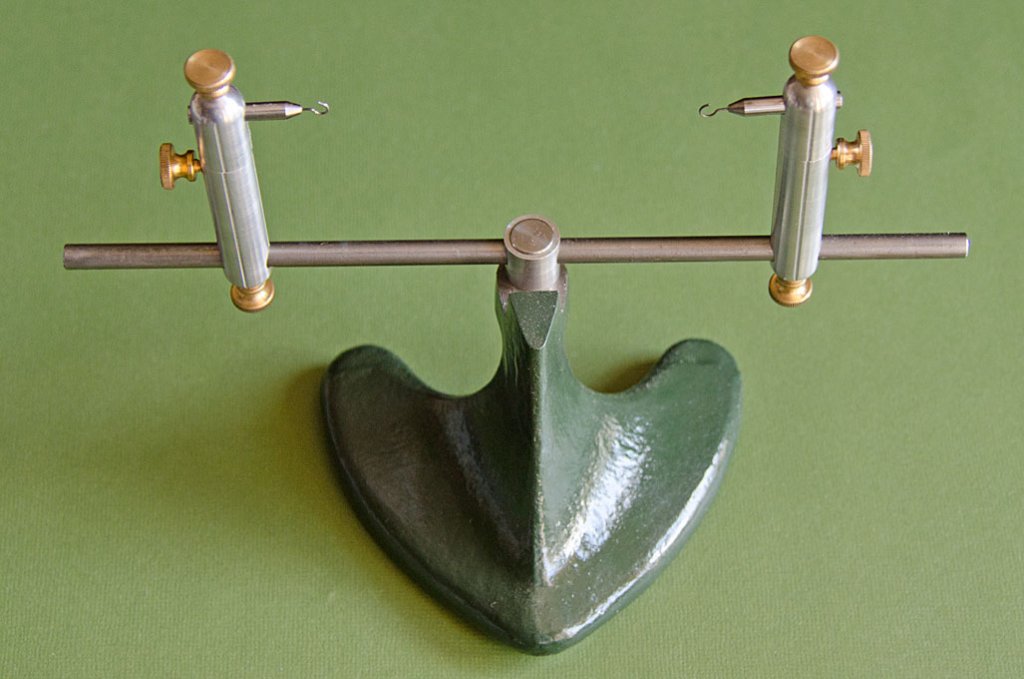
Third hand with small hooks for rigging work
The cast-iron foot was de-rusted and a proper seat for the bar-clamp had to be filed – I could not find a way to clamp the piece to the table of my milling machine. The foot then was primed and painted in my favourite ‘bottle green’ (RAL 6007).
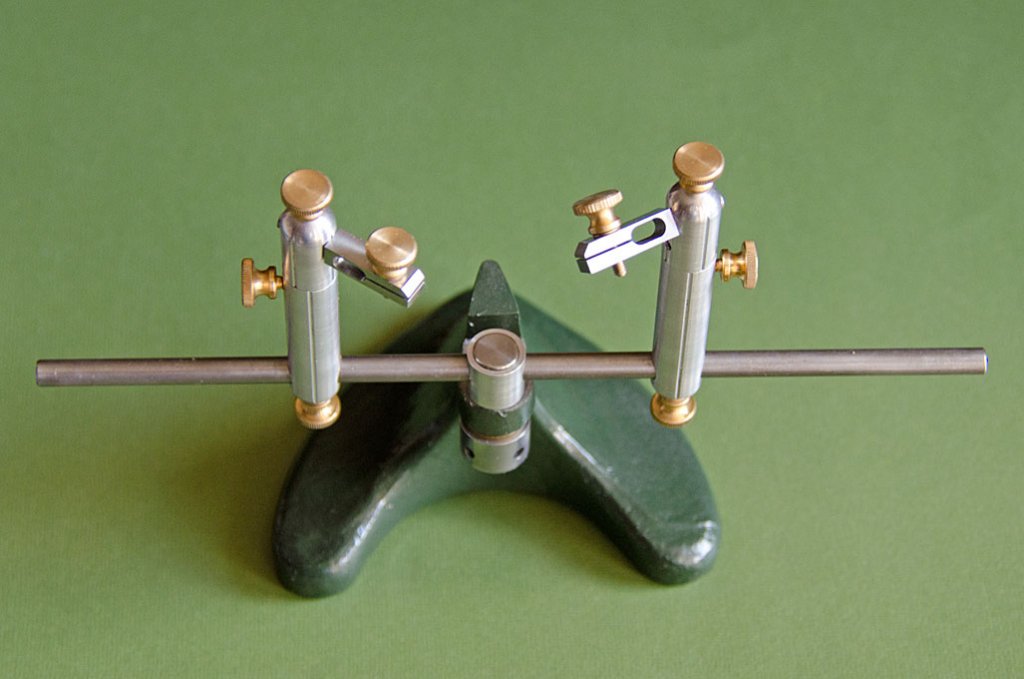
Third hand with small clamps in steel
Working predominantly in small scales with tiny parts, I sized the tool appropriately. The main bar is 6 mm steel and the two pillars are 10 mm aluminium. I actually prefer steel, but in this case working with aluminium was faster on my small machines. The arbors for all the clamps are 4 mm steel rod. The diameter of 4 mm was chosen, as the alligator-clamps have sleeves that are meant to be pushed over 4 mm-banana-plugs.
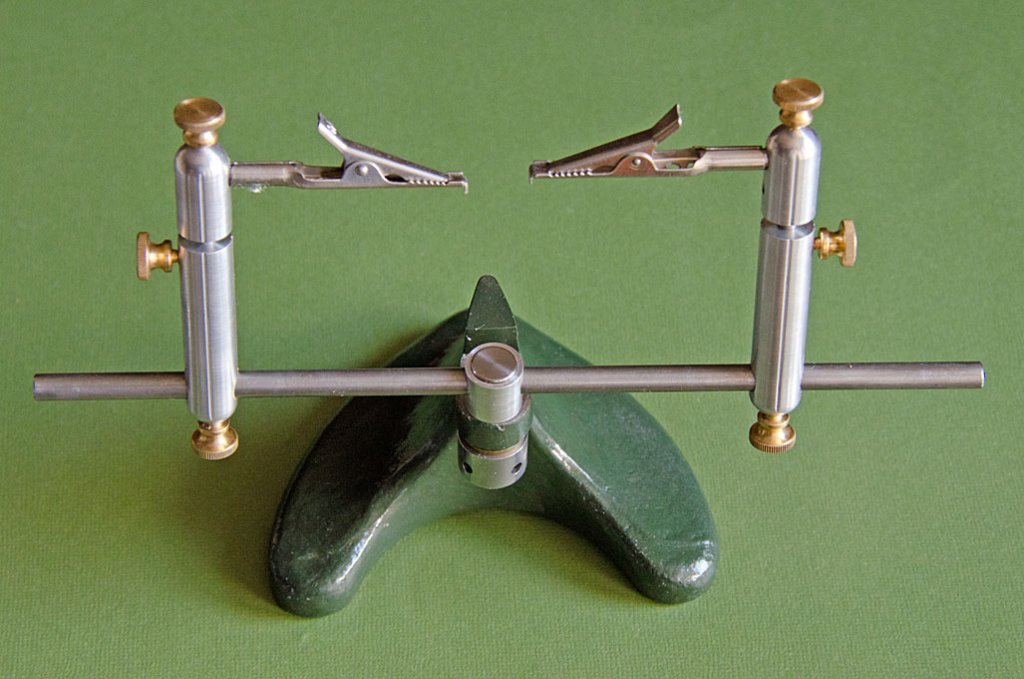
Third hand with alligator clamps
Thinking about the likely kind of applications, I made a pair of small sprung clamps from steel, a pair of larger toolmaker-style clamps (excellent idea by Michael, btw) in aluminium to be used for soldering, a pair of small hooks in 0.5 mm piano-wire for rigging tasks, and a pair of collect-chucks.
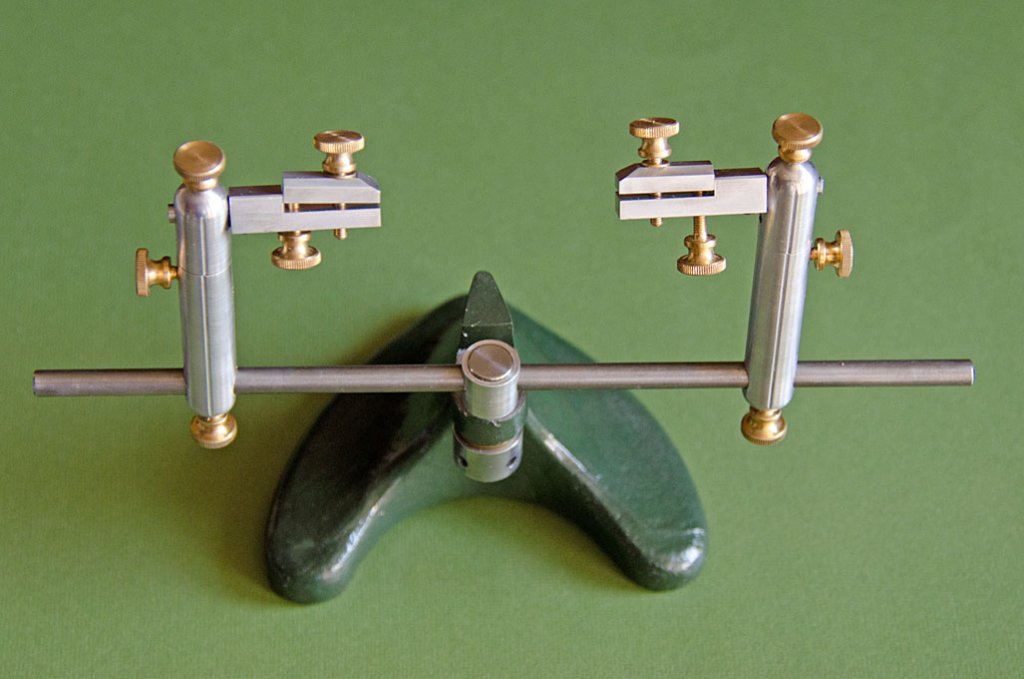
Third hand with toolmakers-style clamps in aluminium
The collet-chucks are a commercial products from China with ten collets that clamp from 0 to 3.2 mm. I thought this might be a good idea for clamping wires and perhaps ropes safely without distortion or marring. They were so cheap at 1.50€ for a chuck with ten collets that there was no point in makimng them myself.
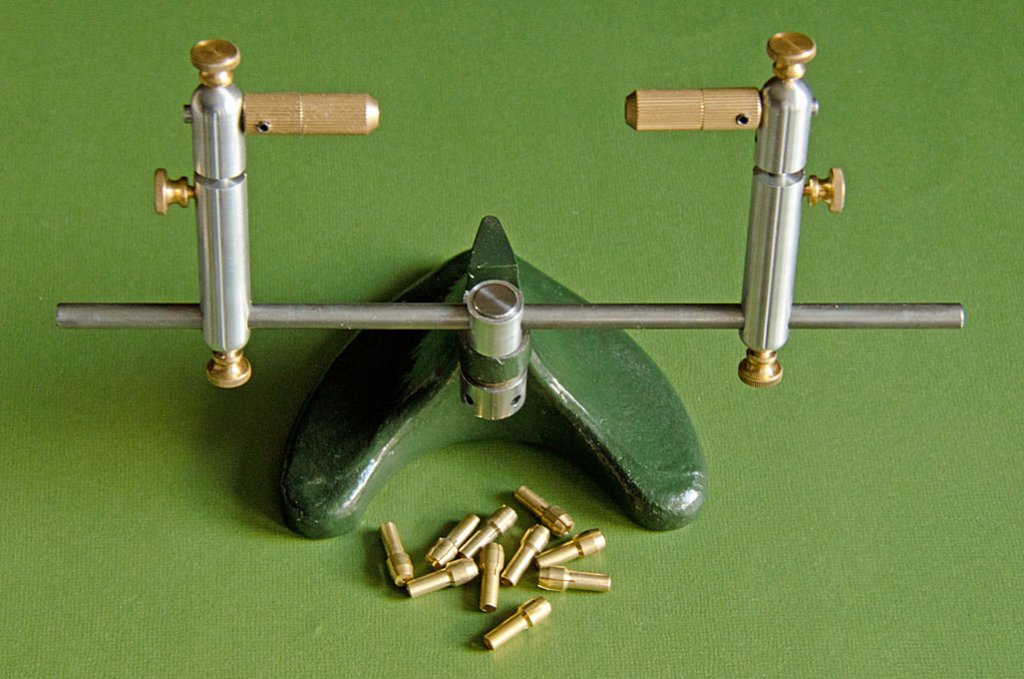
Third hand with collet chucks to hold wires etc.
I also plan to make set of clamps from bakelite for soldering, but have not received the material yet.
The thumb-screws are also bought-in, as I have local source here in Paris that sells them for one Euro a piece, which is not exactly cheap, but good value considering how much time I would have spent making them myself.
-
I have been thinking of adapting a dentist's angled drilling head ('hand-piece') for such purposes, but the problem is that it only takes short inserts with a fixed diameter. So one would need to construct a collet/chuck as well.
The problem with smaller motors is that they have higher RPMs in order to deliver power. Otherwise you don't get enough torque. This in turn needs a well-balanced chuck in order avoid vibrations. In your case I would replace the Philipps-screw with a headless screw (which is what these little collet-chucks come with anyway, as far as I know)
- thibaultron, Canute, mtaylor and 1 other
-
 4
4
-
Found a recipe: 40ml 25% H2SO4; 5 g SnCl2; 50g Thiourea. Add the sulfuric acid to 700 ml distilled water and dissolve the tin-chloride in it, add the thiourea and add more distilled water to give 1 l solution. I would divide the recipe by 10, as it seems to go a long way, the tin layer being only a few micrometres thick. Also the thiourea breaks down after a while which you can see from a yellow layer of elemental sulfur on the inside of the bottle. I have this effect in my commercial product, but it still seems to work. Not sure what the thiorurea does in the recipe.
- mtaylor, popeye the sailor and cog
-
 3
3
-
Actually, no. This is a deoxidiser for soldering-iron tips. Something different from a tin-solutions that plates brass etc. through a chemical reduction reaction.
-
Pat, it is not really a brand, but was sold by a German trader specialising in modelling tools (https://www.fohrmann.com/). I just checked, but they don't list it anymore. Ther German term to look for would be 'Glanzverzinnung'.
Actually, I do have a very useful antique book from the 1880s or so that has a lot of useful recipes for making all sorts of workshop solutions and materials yourself - from a time, when you couldn't just go into a shop or mail-order such things. I should check, whether there is a suitable recipe in it - though nowadays with all those safety and environmental concerns it becomes difficult to buy the ingredients ...
-
Pat, the tinning solution I use is a German commercial product. They don't give the composition, but it most likely contains Sn(II)-chloride, hydrochloric acid and thiourea. You just dip the copper or brass part into the solution and by a currentless (so it is not a galvanic process) electrochemical reaction a thin layer of tin is formed. In itself it may be too thin for soldering, unless the two parts are really pressed together, but with a bit of soldering paste one can easily solder together etched frets. As a matter of fact, I almost always tin my etched frets in this way to facilitate soldering, unless I want the brass colour. Also, when the painting is not perfect, the silvery colour shines through and looks more like iron than the original brass colour, of course.
I also tin like this other brass parts that are meant to simulate iron or steel - this is usually better than painting.
- popeye the sailor, cog and mtaylor
-
 3
3
-
It depends also on what size of areas you would want to paint. For small quantities I use pre-thinned ready to use paints. Of course, you buy a lot of water there, but it saves the hazzle of messing around with thick paints and trying to get a homogeneous dilution. Over here in Europe I have used Schmincke Aero-Color (artists' range), as well as Vallejo's modellers paints. There are quite a few specialist suppliers for modellers on the market now, e.g. Gunze from Japan.
- Canute and thibaultron
-
 2
2
-
PROXXON has been doing something of similar size over here in Europe for many years, but it is a 12V cable-version:
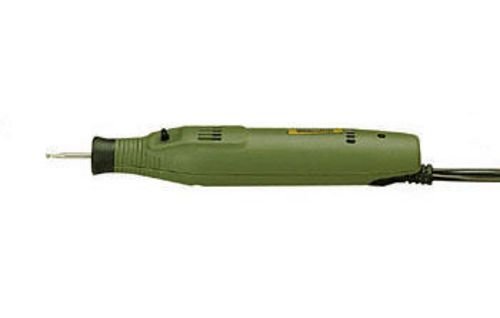
There was a problem with the take-up of the end-thrust by the motor-bearing alone, but I sorted this with a small metal disc at the free end of the electric motor.
- thibaultron, Elijah, Canute and 1 other
-
 4
4
-
I know this etching-problem very well: for instance, you cannot have raised rivets on both sides of a part with just one go in etching. You have to have two parts back to back. I designed my frets so that I have register-holes through which I can insert locating pins and then soldered two mirror-image frets together. As noted above this also has the advantage that you can work with thinner sheet, which reduces the amount of undercutting. To facilitate soldering with a minimum of solder, I cleaned and degreased the frets carefully and then plated them in a tinning solution. For the actual soldering you only need some flux and a tiny amount of soldering paste.
- druxey, popeye the sailor, cog and 1 other
-
 4
4
-
-
I wouldn't necessarily subscribe to the statement that 'historic' paint mixtures have a shorter life than modern mixtures. It always depends on what you are talking about. Mineral paints based on mineral pigments are essentially permanent and form a strong chemical bond with the substrate. For instance, any houses, e.g. in Italy, haven't been painted for centuries and the paint as such remains intact, apart from the general weathering of the surface. Paint on wood is different, as it not normally forms a chemical bond with the wood, but kind of mechanically holds on to it by locking into the surface. 'Modern' and 'historic' seem to have different ageing and weathering behaviour: while old, e.g. lineseed-oil based paints seem to weather over the whole surface, becoming dull and eventually wearing thin and becoming flaky, modern e.g. latex-based paints may have a higher weathering resistance over the surface, but eventually the paint film develops cracks and weathering occurs underneath the paint film, so that it detaches as large flaps.
-
I love these 'steam-punk' details one does not see very often on models. There are several models in the museum in Paris that show such alternatives to the classical dead-eyes, with which the French navy seems to have experimented since the 1830s.
It is interesting to note that many technological innovations diffused only slowly into the navies. Apart from conservativism in the higher echelons one reason is that battle or storm damage was more difficult fix without a shipyard.
- druxey, mtaylor, popeye the sailor and 2 others
-
 5
5
-
-
As geochemist I always try to dig deeper into these things ... Red is used here in Europe too to paint whole houses or the timbers of half-timbered houses. Particularly the country-houses of Sweden in some regions are known for this. The colour there is known as Falu Röd = the Red from Falun (https://en.wikipedia.org/wiki/Falu_red). Falun was one of the big copper-ore producers since the Middle Ages or even before. Apparently, the pigment is derived from the tailings of copper-ore processing and contains finely dispersed iron-oxides, mixed with accesories, such as copper- and zinc-compounds, perhaps also some aluminium-compounds.
The hue of these iron-oxide based pigments depends on the amount of water in the crystal assembledge and, hence, on the amount of firing. Higher temperatures of firing turn yellow ochre into more reddish to brownish ochres. As noted above, the type of binders and fillers further allow to modify the hues.
Unlike these mineral iron-oxyhidroxide pigments that were cheap and are stable in the light, most organic red dyes were expensive and are not so stable.




Albertic by michael mott - FINISHED - Scale 1:100 - RESTORATION - Bassett-Lowke Model
in - Build logs for subjects built 1901 - Present Day
Posted
Liked that luxury long-nosed clamp in brass to catch rigging lines etc. There used to be something similar with a slightly flexible 'nose' (like a Bowden cable) about 10 cm long for electronics people to catch wires for testing in old-time wired boards.
Concerning printed flags: as not all ink-jet printer dyes are permanent (as mentioned by someone further up), I retraced the printed designs in acrylics with very fine brushes. The draw-back is that you loose (some of) the transparency.